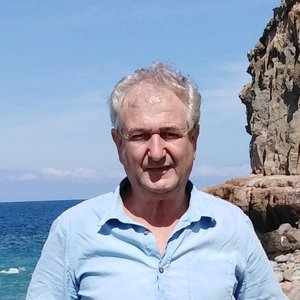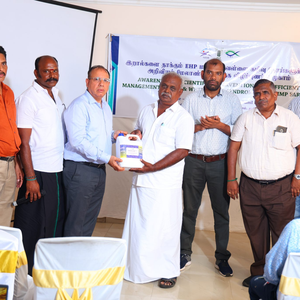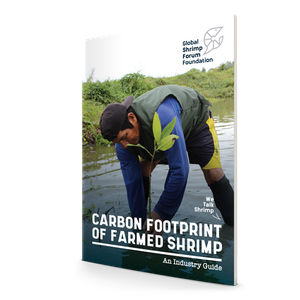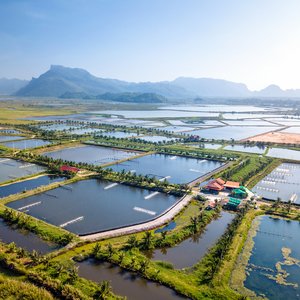The 8th Fish & Shellfish Larviculture Symposium, Larvi 2024, was held in September in Ostend, Belgium. Over its eight editions, Larvi has focused on one specific theme – larviculture of fish and shellfish species – not only a multi-billion aquaculture industry but also crucial for successful aquaculture outcomes.
Organized by the Laboratory of Aquaculture & Artemia Reference Center at Gent University, along with other organizing partners NTNU and SINTEF, this year’s event set a record, attracting over 350 participants from more than 50 countries and highlighting global interest in this specialized conference. Patrick Sorgeloos has chaired the conference throughout the first seven editions and this year, Annelies Declercq, the laboratory’s director, took over. Hatchery Feed & Management talked with Patrick and Annelies to get some insights into the conference’s impact over the years and future prospects.
The early editions
The first Larvi conference was held in 1991, organized by the Laboratory of Aquaculture & Artemia Reference Center at Ghent University. It had a few private-sector participants, mostly from Mediterranean marine fish hatcheries, but the majority came from academia in Europe and the organizers’ cooperative projects in Latin America and Southeast Asia. Across its eight editions (1991, 2001, 2005, 2009, 2013, 2017, 2022, and 2024), the organizers have seen an increase in private-sector participation, reaching about 50% in 2017.
The industry has also changed throughout these years. “Comparing today’s hatchery practices with those of 20 to 30 years ago, there is still much room for improvement. Today, hatcheries are larger, but highly skilled technicians are often no longer operating them, especially in shrimp. For cost-saving reasons, less skilled technicians have taken over, and many of the best practices of the past are no longer considered. For instance, many Vibrio infections in shrimp hatcheries can be traced back to poor Artemia management and algae care, as the foundational practices for producing Vibrio-free Artemia Instar I are often overlooked,” Sorgeloos said.
Larvi witnessed an increased interest in marine fish larviculture, with several new species being considered for farming worldwide. Mollusk and seaweed larviculture seem to have lost attention through the years “although this area of extractive aquaculture deserves more international attention if we want to make aquaculture more sustainable and integrated with ‘fed’ aquaculture,” Sorgeloos said.
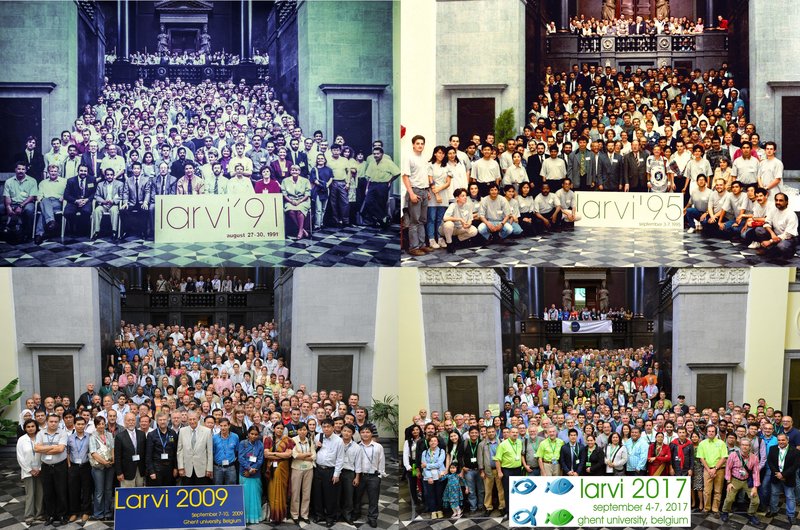
Group photo of Larvi meetings in 1991, 1995, 2009 and 2017
Current challenges
Today’s industry faces several challenges, particularly in making production more predictable. Diseases continue to pose major challenges in both fish and shrimp hatcheries. For shrimp, pathogens like Vibrio and White Spot Syndrome Virus (WSSV) remain serious threats, with additional concerns about emerging diseases. In the first International Artemia Aquaculture Consortium (IAAC) meeting, which took place just before Larvi 2024, discussions suggested that shrimp hatcheries—and possibly marine fish hatcheries—might have reduced Artemia feeding levels below critical thresholds, and with low quality by feeding older Artemia nauplii with lower nutritional value and a higher likelihood of Vibrio contamination. “This doesn’t directly affect larval survival and growth but can compromise immune competence before the postlarvae transfer to grow-out, which may explain the frequent Vibrio-related disease outbreaks in shrimp farms,” Sorgeloos explained.
In fish hatcheries, a variety of diseases are problematic, especially newly emerging ones that pose significant risks because preventive or treatment protocols are not always available. Disease management remains a continuous concern, requiring both preventive measures and quick response systems. Presentations at the Larvi 2024 conference also highlighted these challenges.
Sustainability is another crucial factor, particularly as it relates to scaling production while protecting animal welfare. “Achieving a balance between increasing production and maintaining animal welfare is tricky, especially as hatcheries work to improve efficiency. Sustainable systems, like Integrated Multi-Trophic Aquaculture (IMTA), face regulatory challenges in the EU, where laws currently don’t permit systems that rely on waste from other organisms. These legal restrictions are significant, but Europe is actively reviewing these regulations to support more sustainable practices,” Declercq noted.
Egg quality is also essential, achievable only with broodstock in optimal health with strong immunity and balanced nutrition. “Ensuring a well-balanced diet for broodstock is vital for producing high-quality eggs and larvae. Additionally, diet balance from the larval stage, including live food such as Artemia, remains indispensable. While alternative live feeds are being explored, Artemia and other live feeds still play a critical role in early-stage larval development. Proper enrichment of these feeds, especially with fatty acids, provides the essential nutrients for healthy growth and immune support,” Declercq added.
The future of Larvi
Looking forward, Larvi aims to support hatchery farmers by offering a platform to showcase new technologies, innovations, and results to a global audience. “Hatchery farmers are not just participants—they’re key sponsors, so their involvement is crucial to our events’ success. This creates a mutually beneficial environment where technology and aquaculture advancements are shared with researchers, consultants, and industry peers,” Declercq said.
In the coming years, the organizers anticipate a shift toward more directly applicable innovations—solutions that can be rapidly implemented within aquaculture. This collaboration between hatchery farmers, companies, and academia will be increasingly important. “We’re already strengthening these partnerships, and this will continue in the coming years. We’re actively working on proposals for PhD projects focused on real-world challenges in aquaculture. This approach helps attract young talent to the field, with research and education joining forces to create practical solutions,” Declercq noted.
Companies will also continue to play a pivotal role in Larvi’s future by engaging with students at the event, creating valuable internship and thesis collaboration opportunities. Many companies reach out to Larvi because they see the advantages of connecting with the next generation of aquaculture professionals.
Declercq emphasized the importance of knowledge transfer and capacity building, especially in regions with rapidly expanding aquaculture sectors. “The Larvi community, with its expert network and partnerships, is uniquely positioned to support this. We need to keep building platforms for established experts and emerging voices, like early-career researchers and hatchery technicians. This ensures that advancements are shared and applied effectively across the aquaculture industry,” she added.
Addressing complex issues like sustainability, disease management, and regulatory barriers requires expertise from diverse fields, including biology, engineering, economics, and policy. “At Larvi, we’re already seeing this collaborative approach in action, but moving forward, greater integration across disciplines will be essential for new innovations and sustainable growth in hatchery production,” Declercq said.
“The future of Larvi lies in fostering even deeper collaboration between industry, education, and science, driving practical solutions that will benefit hatchery farmers and the broader aquaculture community,” Declercq concluded.



